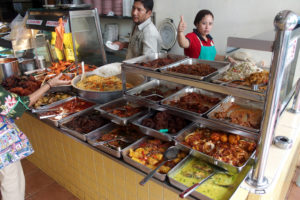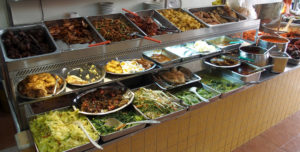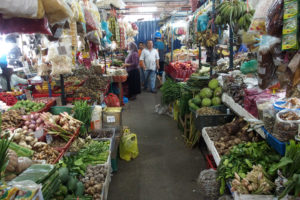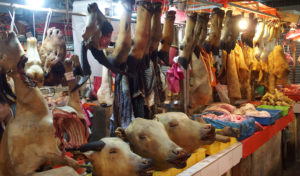As our 30 day visa-free period in Thailand drew to an end, Fern and I needed to figure out how to buy ourselves more time. We still wanted to check out the southern coastal towns in hopes of finding some nice laid back beaches and the whole northern mountainous region was still calling our names. The simplest way was to leave the country and come back, giving us a fresh 30 day stamp in our passports. We picked up a couple of one-way tickets from Air Asia for $38 a piece to Kuala Lumpur, Malaysia. The plan was to work our way up the Malaysian peninsula back toward the southern Thai border.
Kuala Lumpur has never jumped out at me as a place that I needed to visit but since we were flying there it seemed worthwhile to spend a few days absorbing it. We stayed in Chinatown which happened to be where most of the less expensive rooms were and it definitely had a tourist backpacker vibe. The neighborhood had a grimy decaying old-world charm and I was hoping that it would be packed with good street food but instead it was packed with vendors selling clothing, watches, shoes, and cell-phone accessories. The beautiful old Chinese architecture made it a fun base from which to branch out. As we wandered into the surrounding neighborhoods there was something that really caught our attention. Diversity. It wasn’t the first time I’d noticed it in Malaysia. Chinese, Malay, Middle Eastern, and Indian. It was probably the first time we’d been around a sizable Indian population, which fueled our fantasies about going to India.
One afternoon around lunchtime we noticed a long line suddenly forming outside of a little restaurant, which is generally a good indication of quality food. We took note of it and decided that we should come back the next day before the crowd formed. What they offered seemed to be a unique Indian-Malaysian style of dining. They hand you a plate of rice and you choose several things from a heavenly array of richly spiced dishes which are then arranged around the rice. There is usually fried chicken involved as well, in case anyone is worried that I’m not getting enough fried chicken in my diet. Some places let you serve it up yourself and then they just look at your plate to add up the cost. Other places serve it up for you and they make a point of mixing several sauces in the center of the rice on your plate.


This stuff is so good that we sought it out several more times in Kuala Lumpur. It was also our first taste of something that we came to crave more and more as time went on. It’s a particular cut of chicken organ meat that I’ve never seen anywhere else in this exact form but once we came to recognize it, we started to notice it everywhere. What it looks like is a heart surrounded by the lungs, but more likely, it’s the heart and maybe a gizzard and/or liver. It’s all one connected piece which is often fried but not always. It can be pulled apart into the separate organs but it’s generally cooked all together in a tennis ball sized lump. The rich organ flavor is very meaty and nourishing but not overpowering and it holds up well in heavily spiced curries as well as deep frying. To my surprise, Fern liked them even more than I did and she got them pretty much any time they were available.
Excursion to Chow Kit Market
It seemed to me that a chaotic city like Kuala Lumpur would most likely have a pretty crazy traditional wet market but there didn’t seem to be one near our place in Chinatown. I did a little digging and found one that should have been fairly easy to get to on KL’s train system. It should have been. We went to the nearby train station only to find out that we had to leave from a different station and there was a winding maze of tunnels and overhead walkways that we had to take to get there. We eventually found our train and I watched our progress on my invaluable GPS tracking map on my phone. As we hurtled off in the wrong direction it became clear that this was not the right train, so we got off in some random neighborhood that wasn’t close our place or the market and we started walking. I knew that the market shut down early and it was looking like we might just barely make it there in time so we got a taxi instead.
Our driver pulled down a side street to let us out and made a point of telling us to keep a close watch on our belongings. Good advice. We got out and made our way into Chow Kit Market. The main fresh produce area was first and it was abundantly stocked. We haggled for some soursop and made our way over to the adjacent meat section.

One thing I like about Asian wet markets is that they’re not pretty. There is absolutely no effort made to make it a pleasant or comfortable shopping experience. Harsh and barely adequate light bulbs hung from the ceiling to illuminate the cavernous space. Blood flowed through gutters in the floor – just one of the many reasons to adopt the local practice of removing one’s shoes before entering a home or business. Pretty much anything could be obtained and depending on the popularity of the item it would probably be incredibly inexpensive.
As is the norm, there was no refrigeration. I’m consistently intrigued by the lack of refrigeration when it comes to meat. It doesn’t seem to be a major problem which may be at least partially explainable by the fact that everything is so fresh. The supply chain is far simpler than it would be at a grocery store in the US and since products aren’t being stored in warehouses, packaged, and shipped all over the country, they don’t have nearly as much time to go bad. Of course there is a unique and powerful aroma that goes along with this kind of market, which is augmented by the presence of large vats of fermented shrimp and chili pastes.
I couldn’t help but wonder how often some of these cuts actually sold but as I was taking this photo a man came up and started negotiating the price of a cow head. How do I get invited to dinner at his house?

As we worked our way through the market, people smiled at us. They asked where we were from. Some of them seemed a little shy but many people stared at us. We were, in fact, the oddest things in the market since there were no other westerners there and we obviously weren’t buying much. Just having a look around.
Eventually we found ourselves back out in the street and started walking. It seemed to me that we had only seen a small part of the market, but where was the rest of it? I had a hunch that there was much more but it wasn’t obvious where to find it. We swung around a couple of blocks to where I thought it might be and soon we were entering a narrow alley covered with tarp awnings and full of fruit and dessert stands. By this time things were winding down and even though it wasn’t that late, the sky was getting very dark. We just barely made it into the depths of this new section of the market when the sky let loose an onslaught of heavy rain, thunder, and lightning.
Everything pretty much shut down. As vendors covered their wares and water poured in from the weak spots in the quilt of awnings, we wandered through dark narrow passages around an ancient building looking for a way out. We discovered that the market was actually very large, almost like a small covered village and realized that once we emerged into the surrounding streets, we would simply get pounded by water. We found a dry spot in the middle of it and stood there, waiting, listening to the thunder ripping overhead, and watching with a shared sense of amusement as everyone just stood around. It was as if time had stopped. Normal reality was temporarily suspended. No business, no movement, only seemingly limitless water and earth-shaking thunder.
After a while, when the intensity of the storm had let up a little bit, we confronted the fact that we would eventually have to make our way back to Chinatown, whether it was raining or not. Out on the street, it took about 2 seconds for every bit of our clothing to become completely drenched. Fortunately it was nice and warm so we surrendered to the rain and made our way to the train. Since the train went right by Chinatown it seemed pretty simple to get back. Except, of course, for the fact that there are confusingly two stations with the same name. We ended up in the Little India neighborhood, across the river, and even though it was somewhat far, we just walked all the way back.
The long walk back gave us some interesting views of Kuala Lumpur’s architecture. There are plenty of big cities with lots of big buildings in the world but there is something unique about Kuala Lumpur. It’s like architecture on steroids. There is so much construction bursting upward everywhere and the buildings aren’t just big rectangles. They all seem to have unusual shapes and a little bit of personality. Some of them are very old but those are mixed together with newer hyper-industrial looking buildings. Viewed as a whole it almost has the look of a forest – organisms of steel, concrete, and glass growing like plants out of a massive tangle of life on the ground. Not a bad place to get lost, stare out the window of a train, and walk, walk, walk.
jim@snorkelbandits.com
